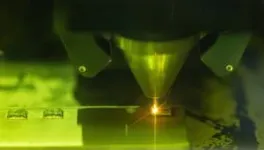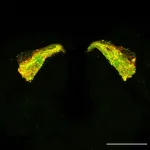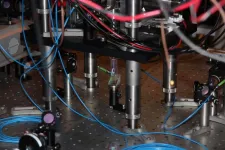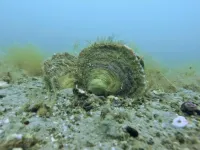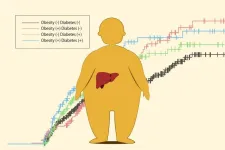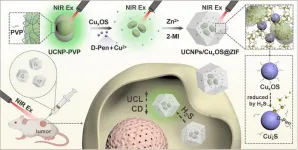(Press-News.org) 10-2-24
Contacts:
Sougata Roy, Mechanical Engineering, 515-294-5001, sroy@iastate.edu
Mike Krapfl, News Service, 515-294-4917, mkrapfl@iastate.edu
Researchers study 3D printing tungsten parts for extreme conditions in nuclear reactors
AMES, Iowa – Sougata Roy, who doesn’t study electrons or grids or wind turbines, has found a way to contribute to a clean-energy future.
“This work in advanced manufacturing, particularly in using additive manufacturing, is about making a difference,” said Roy, an Iowa State University assistant professor of mechanical engineering and a Building a World of Difference Faculty Fellow in Engineering.
Roy has a new four-year, $1 million grant from the U.S. Department of Energy to study the possibilities of using additive manufacturing, known as 3D printing, to create shields and components that could be used in nuclear reactors.
“One of the major things that excites me about this project is working with nuclear energy,” Roy said. “It’s the largest source of clean power in the United States. This emission-free electricity is important for the future.”
(The U.S. Energy Information Administration reports that the U.S. produces about 19% of its electricity from nuclear power. About 10% comes from the country’s wind turbines.)
The grant will allow Roy, as the lead researcher, to assemble what he calls a DREAM-TEAM project: “Developing a Robust Ecosystem for Additive Manufacturing of Tungsten for Extreme Applications and Management.”
Joining Roy on the project are Yachao Wang, an assistant professor of mechanical engineering at the University of North Dakota, and researchers from three of the U.S. Department of Energy’s labs: Ames National Laboratory on the Iowa State campus, Argonne National Laboratory in Illinois and Oak Ridge National Laboratory in Tennessee.
The grant is part of a $36 million effort by the energy department’s Established Program to Stimulate Competitive Research (known as EPSCoR). The program is designed to build energy-related research capabilities and expertise across the country.
The researchers will work with tungsten, a top material candidate for the inner walls of fusion reactors because it maintains strength at high temperatures, has a high melting temperature, resists erosion under high-energy neutron irradiation and retains low levels of radioactive tritium.
But, Roy said, tungsten is expensive for conventional manufacturers to work with because it’s hard and brittle.
So, the researchers asked, what if we try unconventional processing?
They’ll try 3D printing tungsten-based alloys using technology known as laser powder-blown directed-energy deposition. It involves using a laser under oxygen-controlled conditions to process tungsten powder and, layer by layer, print the metal.
Roy, who has experience 3D printing other steel-based alloys for nuclear energy applications, said the project will allow him to purchase a new instrument to characterize the mechanical properties (including the instrumented indentation characteristics and the fracture toughness) of the printed samples.
Roy said the most unique part of the project isn’t the actual printing, it’s the physics-based modeling and computational simulations of the printing process that will complement the experimental work.
The modeling and simulations, which will include work with machine learning and artificial intelligence tools, will help researchers establish the theories behind their experimental results. The simulations will also help them develop recipes for tungsten alloys that can withstand the extreme conditions inside a nuclear reactor.
“We’ll start with pure tungsten,” he said. “Eventually we’ll develop new alloys to resolve this cracking challenge.”
Roy puts the emphasis on the “we” when he talks about the project and its goals.
“This is a real DREAM-TEAM,” he said, “nothing like this project can be done alone.”
– 30 –
END
Researchers study 3D printing tungsten parts for extreme conditions in nuclear reactors
2024-10-03
ELSE PRESS RELEASES FROM THIS DATE:
Promising ‘first’ in Alzheimer’s drug development
2024-10-03
EMBARGOED: NOT FOR RELEASE UNTIL THURSDAY 3 OCTOBER AT 07:00 ET (12:00 UK TIME)
An international team of researchers have made a promising breakthrough in the development of drugs to treat Alzheimer’s Disease.
For the first time, scientists have developed a drug that works on both major aggregation-promoting ‘hotspots’ of the Tau protein - addressing a critical gap in current treatments.
The drug, a peptide inhibitor called RI-AG03, was effective at preventing the build-up of Tau proteins - a key driver of neurodegeneration - in both lab and fruit fly studies.
The ...
Quantum researchers come up with a recipe that could accelerate drug development
2024-10-03
University of Copenhagen mathematicians have developed a recipe for upgrading quantum computers to simulate complex quantum systems, such as molecules. Their discovery brings us closer to being able to predict how new drugs will behave within our bodies and has the potential to revolutionize pharmaceutical development.
Developing a new drug can take more than a decade and cost anywhere from hundreds of millions to billions of euro — with multiple failed attempts along the way. But what if we could predict how a drug worked ...
Experts publish the latest guide for systematic reviews of preclinical research
2024-10-03
A new publication in Nature Reviews Methods Primers provides essential guidance for conducting rigorous systematic reviews on studies with animals and cells. It also highlights the benefits of these reviews, such as improving reproducibility and reducing animal use, and addresses potential pitfalls and recent advancements like review automation.
Systematic reviews synthesize existing evidence in a scientific field to answer specific research questions in a structured and unbiased way. With over 100 million animals used in scientific ...
Oyster reefs once thrived along Europe’s coasts – now they’re gone
2024-10-03
Oysters once formed extensive reefs along much of Europe's coastline – but these complex ecosystems were destroyed over a century ago, new research shows.
Based on documents from the 18th and 19th Centuries, the study reveals that European flat oysters formed large reefs of both living and dead shells, providing a habitat supporting rich biodiversity.
Today these oysters are mostly found as scattered individuals – but the researchers found evidence of reefs almost everywhere, from Norway to the Mediterranean, covering at least 1.7 million hectares, an area larger than Northern Ireland.
The research was ...
Decades-long research reveals new understanding of how climate change may impact caches of Arctic soil carbon
2024-10-03
Utilizing one of the longest-running ecosystem experiments in the Arctic, a Colorado State University-led team of researchers have developed a better understanding of the interplay among plants, microbes and soil nutrients — findings that offer new insight into how critical carbon deposits may be released from thawing Arctic permafrost.
Estimates suggest that Arctic soils contain nearly twice the amount of carbon that is currently in the atmosphere. As climate change has caused portions of Earth’s northernmost polar regions to thaw, scientists have long been concerned about significant amounts of carbon being released in the ...
How Soviet legacy has influenced foreign policy in Georgia and Ukraine
2024-10-03
The legacy of the Soviet Union’s collapse plays a greater role in the foreign policies of Georgia and Ukraine than previous studies have suggested. Conducting foreign policy in former Soviet countries can be a major challenge as the Russian state does not accept the new order. These are the findings outlined in the thesis of political scientist Per Ekman from Uppsala University.
“To understand Russia’s war in Ukraine, for example, it is important to see the war as part of a longer historical event. Since their first day of independence, Georgia and Ukraine have had to deal with Russian ambitions to control the region. For many in the West, it took a ...
Robin Dunbar: Pioneering evolutionary psychologist redefines human social networks
2024-10-03
Oxford, UK – Genomic Press has released a captivating interview with Professor Robin Dunbar, the eminent evolutionary psychologist and anthropologist whose work has fundamentally altered our understanding of human social networks. Published in the Innovators and Ideas section of Genomic Psychiatry, this in-depth conversation offers unique insights into Professor Dunbar's scientific journey and the far-reaching implications of his research.
Professor Dunbar, best known for conceptualizing "Dunbar's number" - the cognitive limit to the number of stable social relationships ...
Balancing health: diabetes and obesity increase risk of liver cancer relapse
2024-10-03
Hepatocellular carcinoma, a type of liver cancer associated with hepatitis infections, is known to have a high recurrence rate after cancer removal. Recent advances in antiviral therapy have reduced the number of patients affected, but obesity and diabetes are factors in hepatocellular carcinoma prevalence. However, these factors’ effects on patient survival and cancer recurrence have been unclear.
To gain insights, Dr. Hiroji Shinkawa’s research team at Osaka Metropolitan University’s Graduate School of Medicine analyzed the relationship between diabetes mellitus, obesity, and postoperative outcomes in 1,644 patients with hepatocellular carcinoma ...
Duke-NUS launches new pictograms to clarify medication instructions, enhancing patient care
2024-10-03
Duke-NUS introduces 35 innovative pictograms to make medication instructions clearer, especially for seniors.
These visual aids are designed to ensure patients take their medications correctly and safely, with the aim of improving overall health outcomes.
The team looks to collaborate with healthcare institutions and pharmacies to standardise pictograms portraying medication instructions across Singapore.
SINGAPORE, 3 OCTOBER 2024 – Transforming patient care through clarity and simplicity, Duke-NUS Medical School has introduced visual aids or pictograms designed to make medication instructions clearer. ...
Chiral nanocomposite for highly selective dual-mode sensing and bioimaging of hydrogen sulfide
2024-10-03
With the continuous development of nanotechnology, more artificial chiral nanomaterials have been constructed. As one of the most representative optical properties of these chiral nanomaterials, CD is a powerful sensing technology. Compared with other analytical methods, CD signal has higher sensitivity, but it cannot achieve in-situ imaging in vivo. Scientists have managed to prepare chiral nanocomposites with more diverse biological functional properties to compensate for this shortcoming. However, some chiral nanocomposites assembled by electrostatic adsorption or other methods are easily dissociated and destroyed in complex physiological environments, resulting in performance ...

